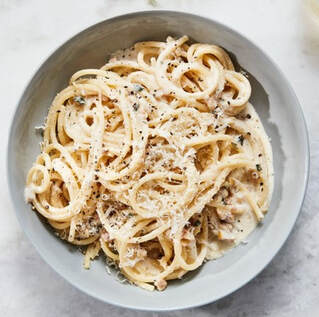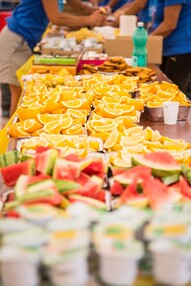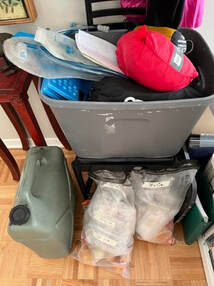The nitty-gritty of the plan
We’ve found a fair bit of research on the nutrition science for high-intensity endurance sports primarily running, cycling, and swimming. During training and competitions, these athletes need to consume easily digested sugars to maintain their energy levels high.
Unfortunately, we could not find any research on nutrition for long-distance walking. So, we’ve adapted the information we’ve gathered with our personal experience to design a plan that hopefully reflects our sport more accurately. Our pace during hiking, and the 24-hour challenge, is typically at a lower intensity than the other sports mentioned above. We know we can tolerate more complex carbs and fats during our hiking days without feeling queasy. We will therefore plan on eating a variety of foods keeping the percentages of fats and carbs almost equal and have a lower protein content during the walking period.
Unfortunately, we could not find any research on nutrition for long-distance walking. So, we’ve adapted the information we’ve gathered with our personal experience to design a plan that hopefully reflects our sport more accurately. Our pace during hiking, and the 24-hour challenge, is typically at a lower intensity than the other sports mentioned above. We know we can tolerate more complex carbs and fats during our hiking days without feeling queasy. We will therefore plan on eating a variety of foods keeping the percentages of fats and carbs almost equal and have a lower protein content during the walking period.
Carbohydrate Loading
|
There are countless techniques to maximise the amount of stored sugar (AKA glycogen) in muscle fibers and the liver. This type of sugar is the foundation for energy production (ATP) for harder efforts as well as a boost when the body utilises fats (AKA triglycerides) for energy during aerobic activities.
We’ve chosen a 6-day protocol for carbo-loading. Here are the main concepts
|
The actual diet changes are different whether you are male or female (of course).
Men can gorge on carbs to the count of 5-10 g/kg per day. As well, they need to reduce their fat intake, but keep up with the protein consumption. Simon will have to keep in mind that the digestive system can only tolerate 60-70 g of carbs/meal. Ingesting more can cause intestinal upset. This suggests that he eat 5-6 meals/day. Poor guy!
Women on the other hand are recommended to increase all macronutrients and not focus on carbs alone. Julie will continue with her 3 meals a day and add 1-2 snacks as well.
Men can gorge on carbs to the count of 5-10 g/kg per day. As well, they need to reduce their fat intake, but keep up with the protein consumption. Simon will have to keep in mind that the digestive system can only tolerate 60-70 g of carbs/meal. Ingesting more can cause intestinal upset. This suggests that he eat 5-6 meals/day. Poor guy!
Women on the other hand are recommended to increase all macronutrients and not focus on carbs alone. Julie will continue with her 3 meals a day and add 1-2 snacks as well.
The Plan - Staying Healthy, Hydrated, and Positive!
Our aim is to do this healthily, if possible. We’ve cleaned up our diet lately and don’t wish to dive back into bad habits. We plan on adding whole grains (farro, bulgar, quinoa), more legumes, and some bread/pasta (multi-grain). We will also add fruit juice, fruit, and yogurt (naturally sweetened with a bit of honey). The fiber in some of these foods will slow the absorption of the sugars to reduce those glycemic highs (and lows) we get from eating more refined foods.
Take note that there may be some water/weight gain during this time. Each glycogen molecule holds 3 molecules of water. It will therefore be important to drink more fluids during the carbo-loading period to avoid becoming dehydrated.
Take note that there may be some water/weight gain during this time. Each glycogen molecule holds 3 molecules of water. It will therefore be important to drink more fluids during the carbo-loading period to avoid becoming dehydrated.
|
During the event our research showed that it is best to plan on an hourly schedule to keep up with the necessary intake of nutrition. To make things ‘brainless’, each hour we will have a baggy with our allotted snacks. These snacks include some fast-digesting sugars (chocolate, honey, puddings, and fruit cups) and slower digesting options (nuts/nut bars, dry fruit, and nut butter energy chews).
For our hydration, it is recommended that we plan on drinking about 250-500 ml of water every hour (effort and weather dependent). In addition, we’ll have a home-made electrolyte drink made with maple syrup, MCT powder (ketones/fats), collagen (protein) powder, and minerals. This mix will be consumed at about 250 ml/hr. |
Positioned half-way along our walking loop (accessible about every 3 hours), we will have a re-supply bin. There we’ll have hot bone broth, ginger ale, and Starbucks sweetened coffee drinks. These special drinks will offer either a nourishing boost (broth), a tummy soothing elixir (ginger ale-burp!), or a caffeinated slap in the face (thanks coffee). For additional snacks we will include chips and sweet potato sushi wraps. These savory/salty treats will come in handy in the wee hours of the night. Eating too many sugary foods during those hours would elevate the production of insulin, leading to an elevated level of tryptophan and serotonin which will induce sleepiness.
Part of the planning deals with the pain-cave and exhaustion. We know it will be painful and difficult at some point during the event. Having strategies to help with the low points may come in handy. Here is what we’ve learned:
We’ll stop at the bin regularly. Here too we need a strategy:
We look forward to seeing how we respond to this challenge. We’re drilling into our heads that we need a comfortable pace, not too slow/not too fast. The aim is to minimise the strain on our bodies.
We’ll keep you posted on how we do!
Part of the planning deals with the pain-cave and exhaustion. We know it will be painful and difficult at some point during the event. Having strategies to help with the low points may come in handy. Here is what we’ve learned:
- We are two and can help motivate each other when it gets tough.
- Using positive self-talk can help a lot. We have trained, we are strong, we can do this!
- Remember why we wanted to do this crazy thing. We want to face the pain-cave!
- Create shorter goals. Shortening the goals makes it easier for our brains to feel successful accomplishing them. We can celebrate reaching the bin or a bench along the way.
- Perform very short (10 second) sprints to boost adrenalin. This will perk us up for a while without over-tiring our bodies.
We’ll stop at the bin regularly. Here too we need a strategy:
- First thing is to stay warm. We’ll change our top or socks if needed, add a layer. Avoid getting chilled which is an energy sapper.
- Ingest some snacks and hydration. Top up our supplies for the next loop.
- Then take a short break. Deeper into the night, we may need a power nap. 15 minutes is sufficient to refresh our nervous system. Longer could mean we would wake up groggy. Once awake, get back on the trail quickly.
We look forward to seeing how we respond to this challenge. We’re drilling into our heads that we need a comfortable pace, not too slow/not too fast. The aim is to minimise the strain on our bodies.
We’ll keep you posted on how we do!



